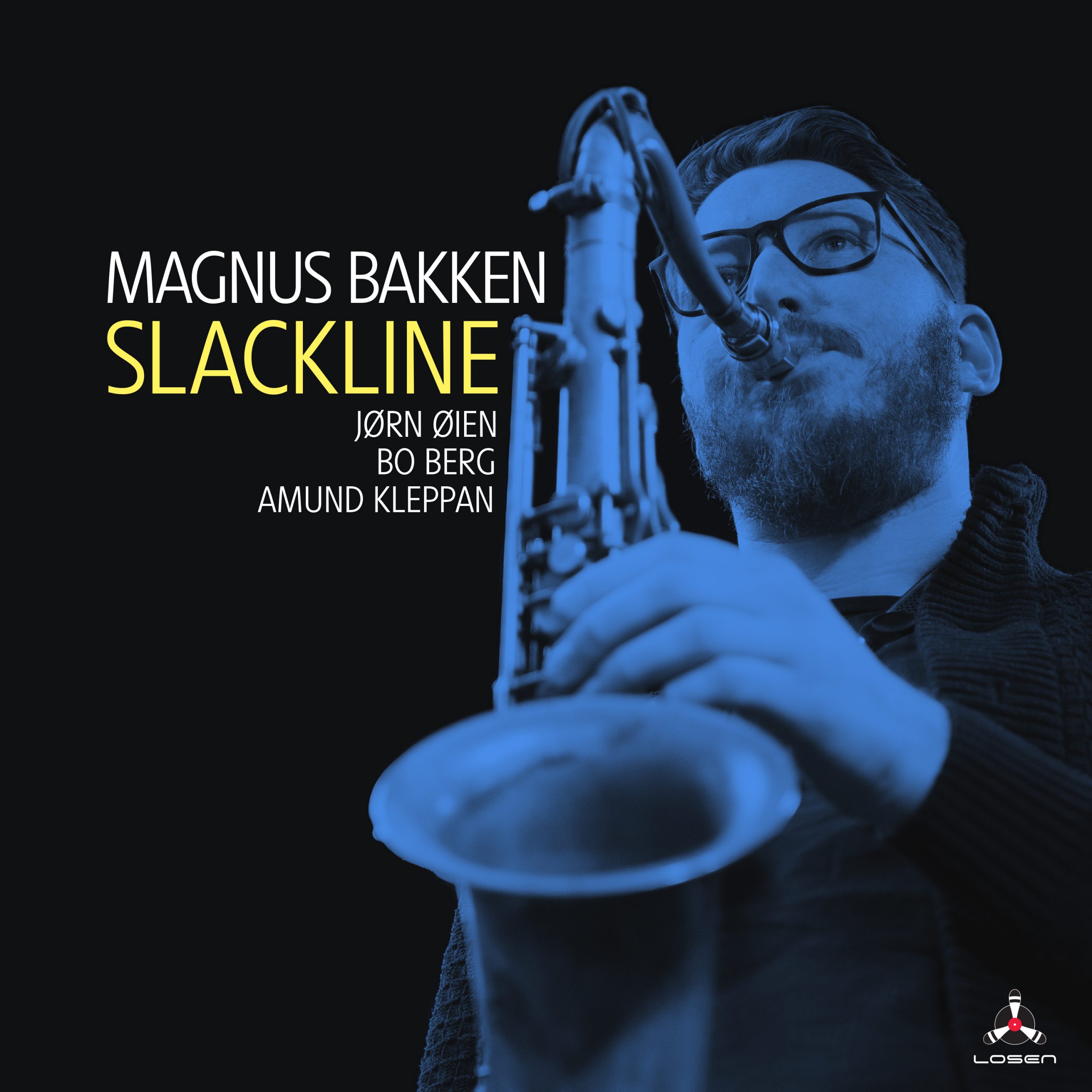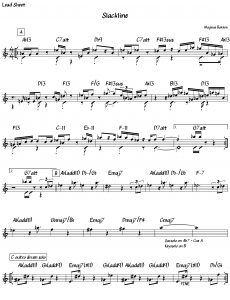In our latest Dorico Showcase article, we spoke to Magnus Bakken, a Norwegian saxophonist, arranger and composer known for his innovative approach to jazz and fusion. A graduate of Berklee College of Music and the Norwegian Academy of Music, Magnus has released several albums as both a leader and sideman. His debut album, Cycles, received praise for its creativity and energy. His latest release, Slackline, out on November 15th, highlights his evolving sound and musical vision. In this interview, Magnus shares insights into the making of Slackline, his creative process, and how Dorico plays a key role in his compositions and arrangements. Read on to learn more.
AN: Hi Magnus, congratulations on the release of your latest album Slackline ! Can you share an overview of the album and how you approached the composition and arrangement process? As a jazz musician, what were some of the key influences or ideas that shaped the music?
MB: Thank you! Slackline is the album I’ve wanted to realize for years, and when Dølajazz Lillehammer Jazz Festival asked me to compose a commissioned work for the festival opening, it gave me the perfect opportunity to bring this music to life. As a composer of instrumental jazz music, I find it important to connect my compositions to specific feelings or memories so that the music resonates more deeply with me. My hope is that listeners can also feel that connection when they hear the music. I approach composition in a variety of ways—sometimes working with my saxophone in hand, sometimes at the piano. No matter the method, one constant in the process is Dorico.

AN: As a jazz musician, you likely bring your own unique perspective to the composition process. How did your background in jazz influence the arrangements and overall sound of Slackline ?
MB: Jazz is all about finding freedom within structure, and that philosophy is central to my approach to writing. I like to approach composing from an improviser’s point of view. When I’m improvising, I’m focused on the overall direction and energy of the music, rather than getting caught up in small details. I try to carry that mindset into the writing process, capturing the essence of a composition first and refining the details later. When writing the music for Slackline, my goal was to create compositions that were clear and distinct, while at the same time leaving room for the musicians to insert themselves. I always keep the musicians I’m writing for in mind, trying to imagine what might spark their creativity. A big part of the process involved bringing the music to the band and hearing how they interpreted it, then going back to the drawing board and adjusting the tunes. The composition In July originally started as a Brad Mehldau-inspired Rhodes etude, but when Jørn Øien played it on organ during our first performance, it completely transformed how I heard the piece. That shift inspired me to write a new melody, and it ultimately became the sacred ballad you hear on the recording.
 Dorico’s seamless integration between Mac and iPad ensures I’m always ready to capture ideas. I can jot something down on my iPad while traveling and refine it later in the studio on my Mac, allowing me to keep the creative momentum going wherever inspiration strikes.
Dorico’s seamless integration between Mac and iPad ensures I’m always ready to capture ideas. I can jot something down on my iPad while traveling and refine it later in the studio on my Mac, allowing me to keep the creative momentum going wherever inspiration strikes.
AN: Throughout the creation of Slackline, what was the most challenging part of the composition process, and how did Dorico help you overcome it?
MB: The biggest challenge in composing is capturing ideas before they disappear. Creativity can be fleeting, and if I don’t jot something down quickly, it’s often gone. Dorico’s seamless integration between Mac and iPad ensures I’m always ready to capture ideas. I can jot something down on my iPad while traveling and refine it later in the studio on my Mac, allowing me to keep the creative momentum going wherever inspiration strikes. Another challenge is maintaining a macro view of the music while composing. It’s easy to get lost in the details, but I actively use Dorico’s playback to reorient myself to the big picture. Hearing everything in context helps me stay focused on the overall flow of the piece, bridging the gap between composition and performance.
The slash region tool is one of Dorico’s most valuable features for my workflow. It allows me to write out detailed parts for playback and then replace them with slashes on the lead sheet, creating a clean and flexible chart while keeping the original playback in tact. This is particularly useful in jazz, where I strive to give musicians the freedom to interpret the music while ensuring they understand the intended direction.
 AN: Were there any particular features in Dorico that made it an essential tool for composing and arranging the music?
AN: Were there any particular features in Dorico that made it an essential tool for composing and arranging the music?
MB: The slash region tool is one of Dorico’s most valuable features for my workflow. It allows me to write out detailed parts for playback and then replace them with slashes on the lead sheet, creating a clean and flexible chart while keeping the original playback in tact. This is particularly useful in jazz, where I strive to give musicians the freedom to interpret the music while ensuring they understand the intended direction. For example, for the tune Three’s A Crowd, I initially wrote out a detailed bass line for the B section but later simplified it to a single bar followed by a slash region. This allowed the bassist to interpret it freely while the playback maintained the original part for reference. This balance of clarity and flexibility is essential to my writing process. Another feature I use all the time is the ability to assign a single player to multiple layouts. This allows me to export the same part as a lead sheet in C, B-flat and E-flat if I need to. And any changes made to the player will appear in all three layouts.
AN: You’ve mentioned using Dorico for iPad during live performances. How has the iPad app enhanced your workflow, especially when it comes to quickly adjusting charts on the go during gigs or rehearsals?
MB: I write a lot of horn section arrangement for events and live performances, often with last minute changes. The Dorico for iPad app has become invaluable for me, as I have my entire catalogue of arrangements with me everywhere, and can easily transpose or make changes at any time. I have had band leaders ask me on the gig if I have a specific horn arrangement in my catalogue, and when I don’t, I open the app, write something up in 20 minutes, and have a polished chart ready for the gig. The app is so fully featured that I often forget I’m working on an iPad—it feels like a desktop app. The portability is a huge advantage. I can make edits on the go, whether it be a last-minute key change or an entirely new horn arrangement. And I can easily pick up where I left off on either device. It’s saved the day countless times and made my workflow far more flexible and efficient.
AN: Having switched from Sibelius to Dorico, how would you compare the two in terms of workflow? What advice would you give to composers considering the switch, and how has Dorico benefited your work on Slackline?
MB: Switching to Dorico has been a revelation. In Sibelius, I often found myself scrolling endlessly through the navigation bar in search of the right tool. By contrast, Dorico’s jump bar makes everything accessible with just a few keystrokes, eliminating the need to memorize countless key commands. For new users, this feature is a game-changer, making the transition smoother and more intuitive. Dorico has reimagined what a notation software should be, and I find the interface so much more intuitive. With the workflow divided into modes—setup, write mode, play mode and engrave mode—it’s much more easy to focus on the task at hand. The engraving process in Dorico is another major advantage. Charts look professional right out of the box, with minimal adjustments needed. For example, I might add a frame break to improve a page turn or tweak a system break, but that’s usually all it takes. In Sibelius, I often spent extra time tweaking layouts to get them to look polished. In writing for big bands, military orchestras and other larger ensembles, the automatic condensing feature in Dorico has been a game-changer for me. It allows me to create clear, professional conductor scores quickly and efficiently—something that required a lot of manual work in Sibelius. For anyone considering the switch, I’d say: try it. It took me about a week to be as efficient in Dorico as I was in Sibelius, and now I’m working much more efficiently.
AN: Thank you, Magnus!
🎧 To listen to Slackline, click here


What font is used for the chord symbols?
@Doug: That’s Petaluma, one of the handwritten-style fonts that’s included with Dorico.